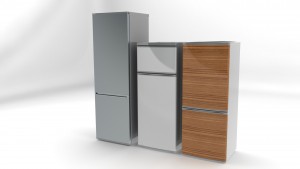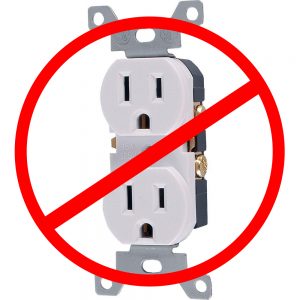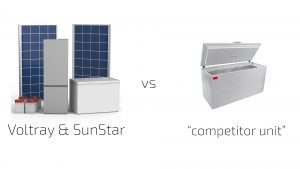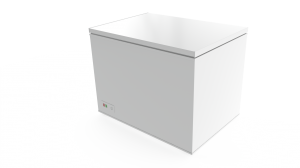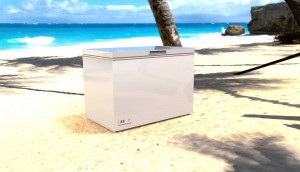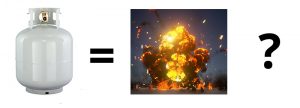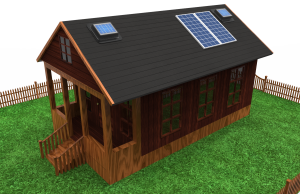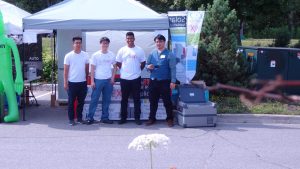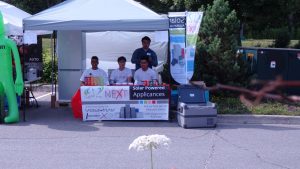Boooo~~~ Hallowe’en updates about possessed and the chance for Possessed Refrigerators and Freezers
Its spooky day today and we’re on the subject spooky possessed refrigerators. Some refrigerators and freezers get the shakes or rumbles. Sometimes, they’ll even DIE! Don’t worry, we’re here to exercise these problems and even possibly bring one back from the depths of the graveyards!
However, preventative measures are the best first steps to avoid unwanted ghastly possessions or untimely ends to your appliances.
- Use only DC parts within the rated specifications of the appliance. Do not attempt to connect any parts to wires, accessories, or other rated objects that was originally meant for AC use. Just because you have spare parts, shouldn’t mean you should use them!
- Follow the regularly scheduled maintenance outlined in your manual.
- Ensure there are appropriately selected breakers at all the junctions of your solar setup that would feed into your Voltray appliance.
- When you ever transport your appliance, let it stand for an hour or two before connecting it back again. If you ever have the appliance sideways (please don’t if you can avoid it) leave it in the upright position for a day or two before turning the unit back on.
So, what if the season is getting cold and you’re not going to be using your appliance? Are you thinking of closing out your cottage or otherwise? Well…
- Turn your refrigerator off.
- Open the doors of your refrigerator. (We recommend securing the door somehow in the open positions. Feel free to be creative in this area. Magnets? Tape? Rope? Just don’t damage it!)
- Disconnect your appliance from the power source.
- Wipe down the interior and dry. We wouldn’t want anything funky when we come back for it later!
“I did all that and my refrigerator/freezer still ended up being possessed/died” Well… unfortunately storing Garlic only prevents vampires, and I want to say that these refrigerators (at the time of this writing) is 100% vampire proof. We’ve had zero instances of vampires getting inside.
We understand that things happen that are beyond your control, *squints* sometimes they are completely in your control. Don’t worry, we’ve got you covered. These are your first steps!
- Reach out to the dealer in which you’ve purchased your unit from and pull out your original receipt.
- If your unit is still under warranty then its wonderful news! We can take a look at it for you. If it‘s an easy fix, we’ll try to get you up and running as soon as we can.
- Your unit is under warranty and you’re close to a service depot? T0hen we can just have it serviced and voilà!
- What if you’re out of warranty? Well, you should still follow these steps. Reach out to your dealer, they’re your main line of contact and they might even be able give you some deal?
- If your dealer cannot provide additional support, then you can reach out to us. Give us some time to deal with what’s going on and we can work towards a solution together.
- Do not be tempted to go with a third party service person. DC refrigerators are different from regular AC refrigerators. The more that someone pokes around, the more damage they might be unintentionally do to unit. More damage = more repair cost. That’s something that no one wants. If your refrigerator was in warranty, then it definitely isn’t once someone that’s unauthorized starts poking around in there.
Just a few helpful tidbits~! If you need anything else please feel free to reach out to us. Have a safe and Happy Hallowe’en!
A C4P PSA: Use only components rated for DC use in DC systems. Do NOT use components rated for AC use in DC systems!
This DC power PSA is addressed to everyone wiring things for their off-grid, cottage, RV, Home, etc. Please use proper hardware for your installation. Some of your equipment cost hundreds and thousands of dollars, so why take the risk?
If you need to connect bare wires to something, make sure you pick up an appropriate DC connector! You’re not sure what that is? Here’s a whole Wikipedia article on the matter (https://en.wikipedia.org/wiki/DC_connector). [Yes i know Wikipedia isn’t a scholarly source, but you get the point of what I was trying to say]. Just make sure that the connectors that you’re planning to get are rated for the amperage load you intend to use it for. Due diligence pays off and your expensive hardware can live to see another day.
Don’t Do it
Please do not connect your DC products to standard AC Connector hardware. Even if you’ve put “DC power” through to the lines connected the AC receptacle, these products are not rated for accept a Direct Current. It is literally not designed to take a DC power load. I get the temptation as to why a person might want to do this. It’s cost effective, helps with organization and more or less contributes to the ease of use for any DC product.
“But if you wire it properly, wouldn’t it work?”
Yes… yes it can. For a while. Then probably not.
It’s like a ticking time bomb of fun events that can occur.
Take our appliance for example, you’d be playing Russian roulette with a $2000 piece of machinery. One surge, one mishandled pulse or signal mix-up and you’d be in a world of trouble. At the end of the day, it’s not rated for that type of use, so keep AC hardware to work with AC systems and keep DC hardware for Direct Current systems.
I’m putting this out there because we’ve had a few instances of this already. Furthermore, please be aware that if you do this, which is also stated in the manual of your appliance, voids the warranty. However, I’m sure that it’d be true for pretty much every product you buy. Regardless, we want you to have a safe home where everything works! This is why I’m writing this PSA.
Please don’t connect AC parts to DC components
I cannot stress enough that these component are built to serve a specific function. It’s like putting regular gasoline in a diesel car, just because you can do something, doesn’t mean you should.
Do NOT use AC components on a Direct Current system. If you must have a plug/outlet, please use the DC standards.
I can repeat this a thousand times and prance down the street, but there will always be someone out there that will feel inclined to try it and realize that it works. Yes it will work. Should you do it? NO! Stop it! Just get the right plugs and save yourself some head and heartache.
Did You Get Your Mother’s Day Gift Yet?
FOSA is a one of a kind Food Vacuum Storage System. It’s also the best gift this Mother’s Day ! It’s easy to use and it helps prevent food waste. That in itself is amazing! It is literally operated by a simple push of a button. You actually can’t get any easier than that.
For specific information, you can always visit Here
Veggies can last 5 times longer with the FOSA system! Salads, Guac, other fresh goodies. You can plan out your Mother’s Day meal prep beforehand! That’s pretty awesome as that’s usually the most time consuming thing with any meal. I mean, you can prep a larger quantity of food (since you know, it keeps longer) in the fridge.
That or if you’re more a meaty person, the FOSA system, can also help keep your meats fresher as it slows down the oxidization process. So yeah! you can easily have a nice backyard BBQ this Mother’s Day !
So what are you waiting for? Visit the Shop Now!
——-
The FOSA: Food Vacuum Storage System is a system that helps preserve food by removing the air out of the storage containers.
It helps preserve the freshness, flavour, and nutrients while preventing premature spoilage.
The FOSA food Vacuum Storage system helps keep food fresh up to 5 times longer.
With a click of a button, you’re on your way to fresher and safer food storage. With the moisture vacuumed out of the container, your foods lasts fresher, longer. The Turtle vacuum unit is small, battery operated, and can easily and happily fit into your kitchen cupboards. The containers are designed with ease of use in mind. The lid has a built in propitiatory seal design that can be activated with a simple press of a button.
C4P: SunStar Chest Freezers vs. our competitors
So how does our 14 cuft. stack up against the competition?
Good question. We’ve been around for over 8 years now, starting with the SunStar units. It’s been a while, and it’s been revised for the better over time. Space hasn’t shrunk, but potentially getting bigger as we look for new more effective materials. It’s the progressive evolution of a product. We were the first with the SunStar 14 cuft. because we have one of most efficient compressor available and we’re always striving to make it better. So… what do I have to back this information? Read on!
Let’s take at our other major competitor in the solar chest freezers.
We’ll take a look at our competitor’s unit stacks against our SunStar Unit. The largest size of chest freezer was introduced as a 14.7 cuft. Sporting a 390L Capacity. This actually translates into about 13.8 cuft. which isn’t quite 14.7. It has been since revised to 13cuft. changing the capacity to a 368L unit. This revision was done quietly and the model is still referred to as a 390. This leads minor change still have vendors refer to this particular unit as a 14 cuft. chest freezer when in fact, it’s 13! If you go to their website, the model states that the capacity is at 368L, the model number implies the older 390L, and the description for the product says the capacity is 378L (This was likely a typo that got missed, but still). So… yes?
Funny Details?
In terms of consumption, here’s another funny little detail I’ve noticed. The competitor’s 13cuft. consumes about 800W in 24hours. This sounds pretty good, almost as efficient as ours and nearly gives us a run for our money. However, the devil’s in the details. Upon looking at the spec sheets, the state that this number was achieved with the freezer set to run at -12°C at 32°C ambient temperature (which is pretty toasty). However, as we noticed in the previous post, the safe temperature as outlined by the FDA is -18°C. So… they’re testing this warmer than what the FDA recommends for safe freezer storage. What we’ve also noticed is that some of our competitors, can’t actually go down to safe freezer temperatures of -18°C. Our SunStar units can go down to a chilling -22°C.
Conclusion
What does that mean? If you get a SunStar or Voltray appliance, you’re creating a smaller footprint. It’s a smaller setup for the same amount of work. It’s money back into your pocket that increases in value for what you need to do. There’s something special about the longevity of a product on market. We’re highlighting our parameters and consumption data because we stand behind our products. Under the same ambient testing temperature of 32°C, our chest freezer only consumes 708W in a 24hr period. However, the difference is that our results are from our freezer being set to -18°C. If it were a fair comparison to many of our competitors, we would use our numbers from testing at -13°C. So In our second data set, our consumption is only 522W in 24hr. That’s almost a 300W difference, a nearly 25% increase in efficiency under the same testing criteria.
Does my Solar Freezer do that?
Throughout history, when we break down the necessities to survive and thrive, we need shelter to shield us from the elements and food to sustain us. Since I’m not going to delve into the subject of shelters right now (maybe another time), let’s look at food (and potentially why a good freezer is important)!
Let’s roll back a litt… okay a lot. These were dark times. Pre Freezer times. Prior to good food storage solutions, storing foods meant a limited run of dry goods that could last or curing, salting, or drying meats. The processes took a long time and if you didn’t do it in large quantities, it wouldn’t be worthwhile. Though, I suppose it would be more of a necessity back then, regardless of quantity. The risks were often high and something going awry can lead to huge losses and setbacks. Given the scale and time it took, there were long windows of opportunity for things to go wrong. Things were tough back then.
If you had the means, you could afford fancy ice boxes. Those are neat, but the advent of modern refrigerators and freezers is what really changed the scope of society. What did this mean? Simple, It meant that people had the ability to keep larger quantities of food safe for consumption for a longer period of time.
This. Changed. Everything.
Production of food no longer meant “just enough”, because excess in production would be waste. Since supply is no longer restrained, maximizing yield lowers the price of food substantially. Since there’s no shortage of supply for consumers, people can buy and store food longer in bulk…. This could go on, but I’m going to cut myself short here before I go on a huge tirade on how food and refrigeration shaped and defined the evolution of humanity.
Back onto freezers! The concept of keeping food cold meant more money for everyone involved. However, science had to keep up. We needed to understand! Which is why we have endless studies on how temperatures affect bacteria and other microbes. All of this has lead up to this one point. What’s the magic number?
-18°C/0°F
The FDA maintains that if you want to store food in the freezer for a long time, your freezer must be at -18°C/0°F. It’s the temperature that stops the growth of bacteria and other microbes. The FDA states that safely handling food at this temperature can keep food good for an indefinite amount of time, thought the only problem would be the quality of the food may decrease over a long span of time (I’m looking at you freezer burn). Freezing goods at a temperature warmer than -18°C could increase the breakdown of nutrients in foods. In fact, something stored at -12°c would degrade at a rate where the it would only have about 20% of something properly kept in the deep freezer.
Though, slightly funny tasting food is still better than food poisoning, so there’s always that.
But guys, what’s the point in all of this? What does have to do with C4P, other than the fact that you guys make solar off-grid refrigerators and freezers? I’m glad you asked.
Our competitors either won’t state their operating potentials as their appliances aren’t as efficient or able to achieve safe freezing temperatures. We can and we do. This is important to us. It’s more than a numbers game, the safety of our customers matter. This is why our solar chest freezers and the freezer compartment for our Voltray solar dc refrigerators goes down to -23°C. We want to keep you safe, by keeping your food safe.
Stay Tuned … We have some exciting comparisons coming soon!
C4P Inc. x 2018 Spring Cottage Life Show
Did you miss us at the Spring Cottage Life Show this year? No worries, I got you covered! Well.. sorta. I’ve got a nice treat for you! 360° video for your viewing pleasure. Granted, there’s some artifacting, I need a better 360 camera! You can check our booth setup, our appliances at the show and much, much more!We’re looking at attending more shows and hopefully, with more videos for those of you too far away to join us. We care about you guys! It was a fantastic show, and we met lots of people. Pretty good chances we’ll be back for the 2019 Spring Cottage Life Show, if not earlier *cough* *cough*
What We Saw
I can safely say that there is definitely demand for solar refrigerators at the cottage. Homes for some folks too. There were people getting gouged for the delivery costs of electricity. It’s insane that people are getting dinged for not even using electricity, but rather access! It’s mind boggling that access is what’s really hurting. There were some folks paying thousands of dollars in electricity fees, despite not being there for months.
What We Heard
There were a lot of people that also didn’t know that solar was a viable alternative for off-grid living. In fact, that we were the most efficient models that available to the general public at the show. We received a lot of high praises when compared to other vendors at the show. So, it doesn’t matter if you’re building your cottage now or two years from now, they’ve put our Voltray Solar DC Appliance on their roadmap.
What We Did
So… we were pretty impressive if I had to say to myself. Not to tout my own horn, but we were the only folks at the show with Solar DC Refrigerators running on a 12V. In fact we had them running during the entire length of the show for all 4 days. Why? We wanted to demonstrate to the fine folks at the Cottage Life Show that our appliances are the most efficient and viable DC choice in market.For More Information Visit our Main Page Here or our shop Here
Beyond dangers of propane?
If it were possible, we’d get rid of all the finite consumable products that are as hazardous to our health as propane is. I’m sure it will reach that point someday; I just wish we were closer to it. Technology will eventually reach a point where the different appliances and functions of our lives will be efficient enough for us to live without necessarily taking away from the earth.
How is it dangerous can it be?
Propane is a gas that’s heavier than oxygen, which makes it an asphyxiant gas. This means that the density of propane will actually displace oxygen in a room or… well your lungs. You can imagine how that could pose a problem for the normal breathing bits.
The other scary part about this substance is how heavy the gas actually is. Consequently, it hugs the ground and sits there, slowly filling up. If you could imagine it’s like water filling up from the ground up. Except the difference is that you can’t see it, you can’t feel it, and if you’re sleeping… you won’t even smell it.
It’s a normally a stable gas, however, it’s extremely flammable and under ideal conditions, extremely deadly. There are so many tragic stories about propane explosions or fires. Homes destroyed and families torn apart from some of these traumatic events.
Safety
If you’re using propane, then please make sure you’re checking and evaluating the inspection of your propane appliances regularly. Propane is heavily scented with a strong odor, if something smells off be cautious. If possible, shut off your fuel cylinders. Evacuate the premises immediately and contact for help from your licensed professionals. Do no attempt to go inside to retrieve your goods, stay away from the premises until it’s clear that you are safe to return.
What can I do?
Furthermore, if you can lower your demand on propane, you’ll not only be doing this for the environment, but you’ll also be doing this, potentially, for your own health. I can’t imagine a lot of Solar Power related explosions… ever. That or even suffocation from solar, but if someone wants to prove me wrong?
Stay tuned for more information in regards to this topic and what your alternative choices are… *cough* it might be solar
External links related to article
Living in a cottage doesn’t have to cost you an arm and a leg in the long run!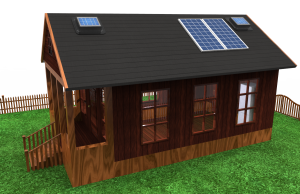
So, you’re getting a new cottage or you’re about to build one. Wait! You’re going to want to hear this before you start!
Time and time again, we have our clients and networks tell us how costly and expensive it is to run electricity out to the rural areas of cottage country. The same sentiments can be had when initially thinking about solar. They’re both costly! However, one is almost always a better choice.
If you need to install electricity from the grid, you’re going to need a power line & pole installed. Depending on where you are in the world, each pole can range between $5 000 to $10 000. Most of our clients usually require at least 2 poles to get from their property to their cottage. On top of the poles, there’s still the issue of wiring, digging, transformers, the meters and other supplementary components for you to hook up to the grid. Even if it wasn’t about the upfront costs, after everything is said and done, you’re still looking at monthly electric bills that you’d have to pay the utilities for using their electricity. As an additional kicker, if you shut down your cottage for the season, you’re still on the hook for “delivery fees”, even if nothing is being delivered.
You could say that your electric bill is a gift that keeps on giving. It’s a system that continually reaches into your pocket for your hard earned money.
If we were to moderately estimate the prices for installation, we’re still looking at costs that are easily in excess of $10 000-$20 000.
$10 000 – $20 000 + more fees = Yikes
If we were to take all that money and invest it into solar, we would be looking at a fairly robust cottage system. The first thing you’d need to do is to size your energy consumption and figure out what you need. When saving energy, it could be as easy as turning something off when you’re not using; like lights, or small appliances. It’s something that’s taught and instilled into the fiber of our being. Use only what you need.
However, there is one thing that you never turn off! That’s right! Your refrigerator! So, of course, it makes life a little more difficult because… well… having food and being able to store food is a pretty cool thing. (Pun was absolutely intended)
However, we do have a solution with our highly efficient Voltray Solar Refrigerator. More on that later.
The other thing you need to keep in mind is that Solar still isn’t a viable option for anything heat related. So that means, no boilers, coffee machines, ovens, stovetops and many more minor things we take for granted. Though there are still solutions for that. You can probably kill multiple stones with one stone with a pellet stove and the like. It can provide heating and a means of cooking too! How cool is that? Something rustic for the cottage space!
The Rundown
So now we’ve figured out heating and heat-related issues, let’s look at the actual build itself. For about $10 000, you can easily get a proper 1.84kW system. That’s our Advanced Kit #4, loaded with a 4000W Magnum Charger/Inverter and 840AH battery in 24V. A system like this can easily recover 380AH on a good sunny day in 5 hours. Our Voltray 11.1cuft Solar Refrigerator only consumes about 35AH a day. That’s barely 10% of the power recovery. You easily have more than 300AH of power left to do whatever you want for the day. That’s quite a bit of juice left over. It wouldn’t be farfetched, to say the least, that you can get some high efficiency LED lights and have your entire space lit up by that same battery pack. In fact, Televisions and other small electronics work well under these circumstances too. Just cut out the microwave and you can see how far this battery pack will take you.
So… let’s have a summary then…
For an excess of $10 000 – $20 000, you can get your utilities to install some power poles to get you grid fed power. Maybe. Then, they’ll charge you varying rates that always seem to go up in cost year over year for some reason and the delivery charges even if you’re not home. You get the gift of accumulated costs that accumulate even more over time.
Or…
You could look at solar. Which, for $10 000, you could get a system that would robustly run our Voltray Solar Refrigerators amongst many other small appliances and lights. You wouldn’t ever need to pay another dime during the lifetime of the batteries. That, and if you’ve sized your systems accordingly, would get you the most reliable and consistent form of energy… the Sun! So long as the sun shines, you’ll never have to worry about blackouts, brownouts, or any kind of network related power issues. The icing on the side is that there are no reoccurring monthly fees. You can modify the system to suit your needs. If you need to expand… expand! Solar panels are usually rated for 25 years, but some have been going strong for 40. Again… no monthly fees, no nickel and diming, no random charges with abbreviated clauses that aren’t clear and have no real defined reason for existing on your electric bill.
So… now that you’ve reached this point, you have to ask yourself. Why not solar?
Feel free to reach out to us and ask us more!
This past weekend our team attended the Muskoka Boat and Cottage Show. We had the chance to speak to many people about their experiences of Solar Solutions and how they planned to live off-grid, as we know the hydro bills up in cottage country is getting ridiculous.
Check out the team that attended the show, don’t we all look happy? From left to right (Johnathan, Michael, Marc, Ken)
These guys were our neighbors for the passed 3 days over our show, Fast Forward Audio – Video. It was an enjoyable time talking to these guys and jamming out to their music beats.
We also had the opportunity to check out the Ribfest that was just around the corner. We got ribs from two different vendors. I would advise to check out Silver Bullet, their pulled pork was the best in my opinion. We also got corn bread that was a little dry for my liking. It also included some beans that were quite tasty.
Looking forward to reconnect with all the people we spoke with and to see what they have planned in their future green-living.
Also check out our Youtube video. It was captured on a Drone! By our associate Ken.
Where to start?
You’re deciding to use solar to go off-grid, great! The next question you may be asking yourself now is “What kind of solar system do I need?”. Have no fear, I will try my best to explain to you on how to calculate a system based on what your usage is.
Firstly, let’s get some terms out the way so we can have a better understanding as we proceed.
- Load – Power consumption within a day of what you are using such as appliances, lights, and charging your phone or laptops. For our instance, we should use Amperage as it is easier to use than Watts.
- Amperage – The strength of the electric current.
- Voltage – The pressure electricity is moved. Usually it is supplied by a battery or generator.
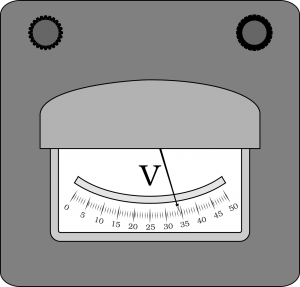
Solar Fridges
Now for our situation let’s use our DC solar optimized refrigerator, the Voltray 11.1 CU. FT. The load/energy rating for this appliance is rated at 55.1 amps on a 24-hour consumption. Let’s factor in an extra 10 amps to this because the values are achieved by industry standard are done with doors closed settings. It’s because people are actually meant to use the appliance. It’s not art, it’s functional and mechanical, which is why we factor in extra amperage draw. Every time a door is opened, the cold air dumps out from any refrigerator, forcing the compressor to kick on and compensate for the energy loss. Which is why, the more you open a refrigerator, the more it has to run and the less efficient it becomes.
The Math
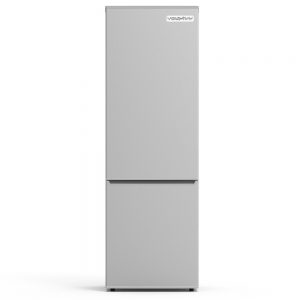
Now that we have the amperage which we calculated to be approximately 65.1 A. We can now move on to the math portion of this post. So, what kind of battery will we need? For the sake of this entry, we will be using a 12-volt golf cart battery system.
To calculate the wattage, we will use this formula: Amps = Wattage / Voltage. So, we have our Amperage and Voltage but we’re missing our Wattage. In order to get the wattage, which would be our amperage multiplied by our voltage, we get 65.1A x 12V so, it results in 781.2W.
If we factor that in most places around the world we would not have optimal daylight for more than 4 hours. So, let’s divide our total wattage of 781.2W by 4 hours which gives us a consumption rating of 195.3W/hr of real world usage (opening and closing doors). This means we would need a 195.3W minimal of wattage to recover our daily load.
Now that we have all our total numbers we know that we need a minimal of 195.3W. We usually like to round up to factor in unforeseen circumstances. We put these numbers to have 3 days of autonomy. This allows for downtime to repair a system if something comes up or if you have the nastiest weather such as rain for 3 days.
Conclusions!
We would need to at least double the 65.1A rating. We don’t want our deep cycle batteries to drain any lower that 50% as this will damage the life cycle. This will need at least a 130.2Ahr battery system per day. In order to compensate for day to day usage, we usually scale our system for 3 days of autonomy. It’s just in case if you had a stormy/cloudy day or two. In order to scale up for three days, you can either take the daily system and increase it 3 fold, or take the consumption of the unit and increase it by a factor of 5-6. This is to factor in the 3 days of autonomy. This will give us roughly 325.5 – 390.6 Amp/Hour 12V battery system. This is the total amount of battery power we will require to run this system for 3 days without damaging the battery.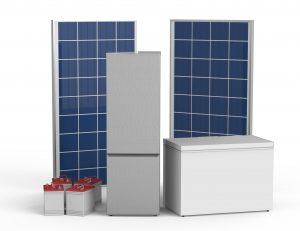
To conclude you would need a solar panel or solar panels that will equal to 220ish Watts, 200 if you are really trying to save which I would not advise. Also, you would require a battery or equivalent to 325.5 – 390.6 Amp/hour 12V battery system.


